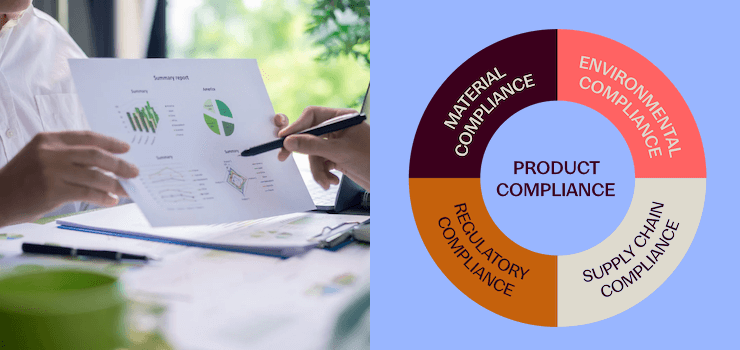When it comes to materials in products, what we call “end of life” is also the “beginning-of-life”. This idea isn’t new, but only around 20 years ago the mindset started to change and challenge the old-fashioned cradle-to-grave approach to managing material life cycles (linear economy). This idea that materials shouldn’t be wasted when a product reaches its end of life is captured under the broader term “circular economy”, which covers much more than materials. It looks at the entire system of how we design, finance, produce, and consume goods and services, across all sectors of the economy, and how we treat them beyond their useful life. Circular economy focuses on the social, environmental, and economic benefits not only for individual actors, but also for the broader value chain. According to the publication Growth within: A circular economy vision for a competitive Europe by the Ellen MacArthur Foundation and McKinsey Center for Business and Environment, the potential economic benefits of going circular “could boost Europe’s resource productivity by 3 percent by 2030, generating cost savings of €600 billion a year and €1.8 trillion more in other economic benefits.”
Material life cycle management process – a key success factor
Setting up a complete end-to-end material life cycle management process is a key success factor for any company, but particularly for large multinational organizations. For automotive OEMs, the cost of raw materials is a significant contributor to overall vehicle production costs (45-50%). Managing materials efficiently and reducing material costs and waste has a tremendous impact on profitability. For a major OEM, a 2-3% reduction in material costs translates to billion-dollar opportunities. This is where an end-to-end material and substance management process plays a key role, as it can provide benefits far beyond material compliance management. Appropriately integrated, it can work in conjunction with core product development, design and engineering, manufacturing, supply chain management, and risk management processes to achieve business objectives, sustainability goals, and an easier transition to the circular economy.
Different stakeholders have different interests in materials and substances
The process should cover all key areas. An effective material and substance data collection and analysis can support an in-depth approval review process. An effective tool would allow multiple stakeholders to work seamlessly together in reviewing new and existing materials and substances. Consider the different aspects of an effective and thorough approval process for a typical manufacturing company: Product designers and engineers will review material specifications, test data, and assess the quality of a material. The Environmental manager wants to review environmental data, corresponding regulations, and also perform risk analysis. Health and Safety officers need to evaluate the impacts and risks of putting materials and substances into the workplace. Companies also have toxicologists, purchasing officers, facility managers, inventory managers, and possibly many more stakeholders who all have different interests in materials and substances.
Teams operate in silos
Despite the clear need for a more harmonized approval process, stakeholders still operate in silos. The material and substance approval process is often duplicated across locations; material specifications and data already collected by one team may not be available to another. Certain departments may not have access to critical information about what certain suppliers actually supply – and in the case of Conflict Minerals this could be a significant risk. Substance and material data gathered for compliance purposes can assist designers and engineers to make better choices – and design for compliance and sustainability, significantly reducing the risks of product remanufacturing, delays, and recalls.
Separate processes and tools must become integrated in core business processes
This stream of separate processes and tools should become integrated and incorporated into the organization’s core business processes and supplier management in a way that it is auditable, with roles and responsibilities clearly defined. Without a robust business process, one cannot build efficient IT tools to support the business bottom line effectively.
This article is the fourth in our series of nine articles dedicated to the topic “From Compliance to Sustainability – Managing Material Lifecycle in the Circular Economy Era”. It is addressed to senior decision makers, managers, compliance officers, engineers, and any corporate citizen interested in the most important steps of your journey from compliance to sustainability. Starting with material compliance, we will explore the entire material life cycle and the connections between corporate sustainability goals, circular economy, and digital technology. Thereby, we will lay the focus on business processes, IT solutions, and the utilization of data as the three key elements which – in combination with sustainability and the circular economy – create greater value for companies and their value chains.
About the authors
Maroye Marinkovic is the Product Innovation Manager at iPoint, where he brings in his skills as a solution designer, digital strategist, and a communicator with a passion for improving sustainability, efficiency, and compliance across value chains. Based in Melbourne, Australia, he has more than 10 years of experience in conceptualizing, designing, and implementing enterprise compliance, sustainability, and risk management software solutions. Maroye’s specializations include chemicals management, platform design, blockchain solution design, circular economy, and business strategy.
Dr. Bing Xu joined iPoint in Ann Arbor, Michigan, at the North America main office in 2019 as Director of Business Innovation. In this role, he supports iPoint’s customers in different industries with their material compliance programs as well as their sustainability, circular economy, and digital twin projects, to integrate material compliance programs into their core product development processes and reduce non-compliance risks and improve engineering efficiency.
Before joining iPoint, Dr. Xu was Ford Motor Company’s Global Materials Compliance Program Manager. Spearheading Ford’s Global Materials Management program in early 1997, he was one of the original OEM members who developed and launched the International Data Management System (IMDS) for the automotive industry in 2000. He was Ford’s global attribute leader for material/substance compliance and material life cycle management, and a member of Ford’s Sustainability Council, managing both internal compliance and external suppliers’ compliance. He also led Ford’s cross-functional teams and developed various material compliance-related processes and IT tools for Ford since 1997. Furthermore, Dr. Xu was the owner of Ford’s Restrictive Substances Management Standard (RSMS) and the owner of the Ford’s internal material/substance compliance processes/tools.
He has served as chair and co-chair in several committees of leading industry organizations and work groups, such as the US Automotive Industry Action Group (AIAG)’s Chemical Management Advisory Group, the United States Council for Automotive Research (USCAR)’s Substances of Concern Group, the Global Automotive Declarable Substance List (GADSL)’s Steering Group; and he has supported projects of the US Environmental Protection Agency (EPA) on Alternative Assessments, and TSCA industrial data collection and evaluations.
A recognized and highly respected expert of the automotive industry, he has been invited to speak at many conferences and forums hosted by different industries and governmental agencies, e.g., Electronics, Building Materials, Heavy Machinery, Chemicals, Apparel, Home Appliances, California Safer Consumer Products and Alternative Assessment conferences/workshops, and SAE US Government Industry Meeting.





.png)
